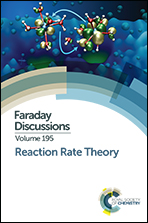Faraday efficiency and mechanism of electrochemical surface reactions: CO2 reduction and H2 formation on Pt(111)
Abstract
An atomic scale model of the electrical double layer is used to calculate the mechanism and rate of electrochemical reduction of CO2 as well as H2 formation at a Pt(111) electrode. The water layer contains solvated protons and the electrode has excess electrons at the surface. Density functional theory within the generalized gradient approximation is used to describe the electronic structure while the mechanism and activation energy of the various elementary reactions is obtained by calculating minimum energy paths using the nudged elastic band method. The applied electrical potential is deduced from the calculated work function. The optimal reaction mechanism for CO2 reduction to either methane or methanol is found and the estimated rate compared with that of the competing reaction, H2 formation. When the free energy of only the intermediates and reactants is taken into account, not the activation energy, Pt(111) would seem to be a good electrocatalyst for CO2 reduction, significantly better than Cu(111). This, however, contradicts experimental findings. Detailed calculations reported here show that the activation energy for CO2 reduction is high for both Heyrovsky and Tafel mechanisms on Pt(111) in the relevant range of applied potential. The rate-limiting step of the Heyrovsky mechanism, *COOH + H+ + e− → *CO + H2O, is estimated to have an activation energy of 0.95 eV at −0.9 V vs. standard hydrogen electrode. Under the same conditions, the activation energy for H2 formation is estimated to be only 0.5 eV. This explains why attempts to reduce CO2 using platinum electrodes have produced only H2. A comparison is made with analogous results for Cu(111) [J. Hussain et al., Procedia Comput. Sci., 2015, 51, 1865] where a reaction mechanism with low activation energy for CO2 electroreduction to methane was identified. The difference between the two electrocatalysts is discussed.
- This article is part of the themed collection: Reaction Rate Theory

 Please wait while we load your content...
Please wait while we load your content...